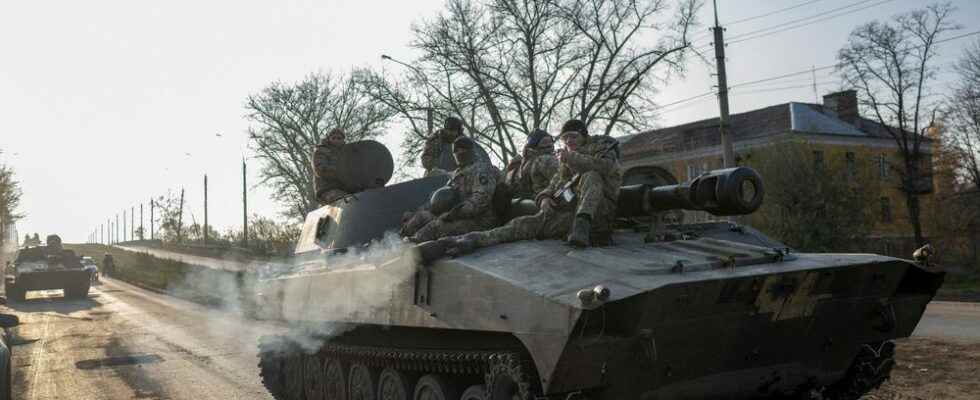Several days after the actual departure of Russian troops on November 11, Kherson residents continued to gather in the aptly named Freedom Square, waving blue and yellow flags there. Such scenes of jubilation, Ukraine hopes to see others in the months to come, after the resumption of control of more than half of the territories lost after the invasion of February 24. During his address to the G20, President Volodymyr Zelensky thus confirmed the continuation of the offensive, to prevent Russia “from waiting and strengthening its forces”.
In fact, the reconquest of the western part of the Dnieper River offers kyiv the opportunity to continue its momentum, in the face of a Russian army unable, for the moment, to turn the tide. “The Ukrainians have the momentum and the initiative in this war and won’t want to waste it, I think we’ll see more attacks soon,” said strategist and former Australian general Mick Ryan. “Winter can slow down operations, but he will not stop them.”
Without being able to rule it out, the hypothesis of a crossing of the Dnieper seems unlikely. Wide, with no fixed means of crossing after the destruction of several bridges, the river constitutes a natural obstacle. Added to this is the strengthening of the Russian defenses on the eastern shore and the risk of exposing themselves to a deluge of shells without an easy retreat. “The Ukrainian army is more likely to consolidate its control of the western bank, leaving enough forces to deter any Russian attempt to cross, while reallocating forces to other areas,” said in a statement. note from the Institute for the Study of Wara Washington-based think tank.
After Kherson, three front lines are likely to be the scene of a new Ukrainian effort: those of the oblasts of Donetsk, Lugansk and Zaporijia. “It would be complicated to advance towards Donetsk, a very fortified area since the 2014-2015 war, estimates the former colonel of the navy troops Michel Goya, now a historian. There is Lugansk, where the Ukrainians attack , are trampling, but could open the door of the region, if they take the city of Svatove. They can also try to break through in the direction of the South towards Melitopol, in the region of Zaporijia, a flat ground favorable to the maneuver, where there have been no major operations since March.”
Ukrainian soldiers on an armored vehicle, on the outskirts of Bakhmout, November 9, 2022.
afp.com/BULENT-KILIC
“A major escalation in the Donbass”
Also on the Russian side, the redeployment of troops should lead to an intensification of the fighting, as has already been the case since the end of October, on the side of Bakhmut. “Only the promise of success in the East could allow General Surovikin [le nouveau commandant en chef de “l’opération spéciale”, NDLR] to make Putin accept the idea of a retreat from Kherson, believes Andriy Zagorodniouk, former Ukrainian Defense Minister, in a to analyse published by the American think tank Atlantic Council. Ukraine must prepare for a major escalation in the Donbass region in the coming weeks.”
To do this, Moscow is counting, in addition to the relocation of its troops, on the partial mobilization of more than 300,000 men. “A first echelon of 100,000 left immediately to contain the Ukrainians and be massacred, while a second of 200,000 must be trained, equipped and engaged in the weeks and months to come, indicates Michel Goya. The Russians hope to get back on track through this, but it takes a real coaching infrastructure and I’m not convinced they have it.”
In this regard, it will be difficult for them to catch up with the Ukrainians, whose training of mobilized soldiers, motivated by the defense of their nation, began the day after the invasion, without ever ceasing. “Since August, they have more combat units than the Russians and are much better tactically, which means that they win, continues Michel Goya. It is hard to imagine this superiority called into question in the two or three months. Two new Ukrainian victories in the winter would greatly shake the Russian army and regime, others in the spring could lead to their collapse, like Germany in 1918.”
Increasingly less confident, Russia has begun to reinforce defensive positions on land crossings to Crimea, recent satellite images have shown. “They are clearly concerned about a possible ground attack by the Ukrainians against Crimea at some point, notes Mick Ryan. The Ukrainians have attacked it several times from the air and the sea and their president has been clear about his desire to take back the peninsula.” A less and less improbable scenario, if the Ukrainians manage to chain successes.
